The hand in which Doug Polk made an expensive bluff against Tom Dwan, who had a full house, interested me for both players, but especially for Dwan since his decisions on the turn and river were not obvious. On the river, he thought for a long time, and some viewers suspected him of nit rolling, although in fact he, of course, chose between calling and going all-in. But in the end, he did not dare to go all-in over his opponent's huge overbet.
The results of the analysis often depend on the conditions we specify. I do not think that such a study, in principle, can establish the final truth. In addition, even if the solver clearly prefers one solution or another, this does not always mean that you need to play that way. In addition to the technical side, the players took into account the reads and the dynamics of the stand-up game, the rules being that one must not be the last of the participants who did not win a single hand during the allotted period.
It is often said in statistics and modeling that "All models are wrong, but some can be useful." I think the same applies to our case.
Hand
The effective stack is a million. Doug raises 3k from the CO with . Dwan 3-bets 14k from the small blind with . Doug calls. Flop , Dwan has the second set, no one has diamonds, but Doug has a backdoor flush draw. Dwan bets 15k (half pot) and Doug calls. On the turn Doug has an open-ended straight draw. Dwan again bets half the pot, Doug raises to 120k, Dwan thinks for a very long time, and calls. On the river comes another six . Dwan checks, Polk overbets 420k with 5-high, Dwan thinks for a long time again and decides to call.
A few words about reads
Although I will mainly focus on solver analysis, I want to first share some thoughts on reads as well. It seems to me that Doug was in vain telling everyone that he came to fight. Dwan won the most this evening, playing mainly by check-calling. I think Doug wanted to please the fans, and Wes tried to get rid of the reputation of a nit. Both of them had hands that were both bluffing and holding back, but they decided to go all the way, and I think Dwan was ready for that.
It's also worth mentioning in this hand that Wes saw Doug's cards and said, "I like this hand" – this is usually said about a nice suited connector, and not a high pair like . Doug, apparently, was trying to change his image from a stern pro to an entertaining businessman who could decorate any game, but he paid a high price for this.
Dwan is not a solver, but a great analyst who can play against the meta. I think he had both specific reads on opponents and general ideas about tweaking for each of them.
Ranges
A Dwan 3-bet from the small blind will be top of the range, high-suited cards, suited connectors, and some offsuit broadway cards.
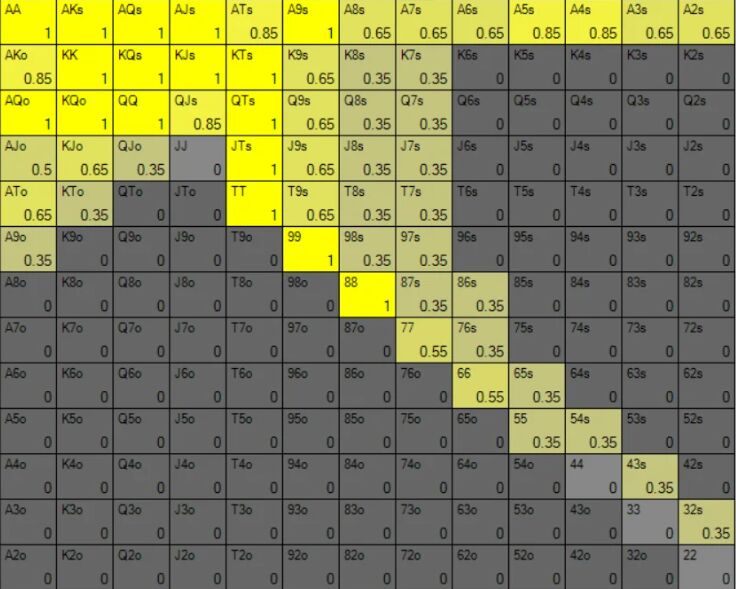
Doug's call in position... I think with his fighting spirit plus the stand-up game we can give him all pairs, most of the suited connectors and gappers, as well as a lot of broadway cards.
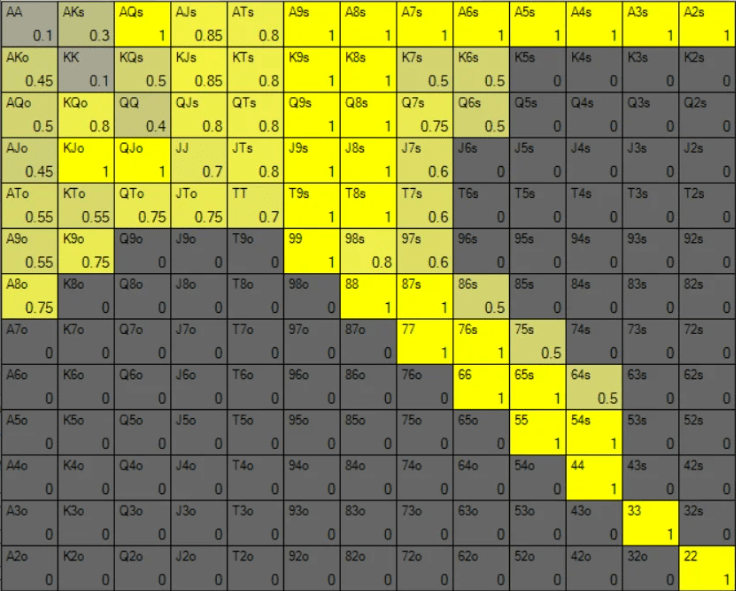
I gave Doug 10% to call with , but, to be honest, I can hardly imagine such a slow play in the current situation. This is important because later will be the most relevant combination.
Flop
On the flop, Dwan checks about half the time. When he bets, the solver prefers a small sizing. A set of sevens often bets because it doesn't block top pair or flush draws.
Doug's answer, I've found, is very dependent on the range assigned to him and the sizings we've chosen. In almost all cases, his hand mixes all three options – fold, call, and raise.
In the simulation that seems closest to the truth to me, most of the time he calls. It might surprise some people to call so loose on the flop, but don't forget two things. First, small bets should not be given up too often, otherwise, you will be crushed by cheap bluffs. Small stakes are effective just because few people know how to properly adjust to them. Secondly, in very deep stacks, the current strength of the hand is not as important as the ability to make a strong hand on the river. If Doug catches a runner-runner against Dwan's set, he could win a giant pot.
Like the other big pot of the same evening, there aren't many nuts in the players' ranges on the flop, so it's important to have river prospects. This is a key aspect of deep stack play and the main reason why sides play so much looser than the standard 100bb.
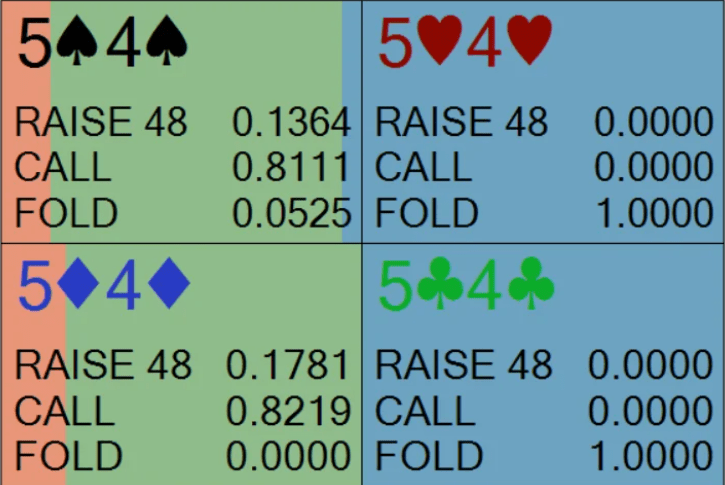
Turn – Doug's semi-bluff decision
On the turn, Dwan should again mix bets and checks, and sevens can be played either way. The check is due to the fact that there are a lot of top pairs in his range with weak kickers who want to get to show down cheaper. To protect these hands from bluffs, you need to check (and check-raise) some sets.
Dwan decides to bet half the pot again. The solver prefers to increase the sizing, but half the pot is also okay, the expectation is about the same.
Again, I have to say that Doug's decision depends too much on the initial configuration of his range. In the simulation that I liked the most, open-ended calls are always played, and combo draws go to raises.
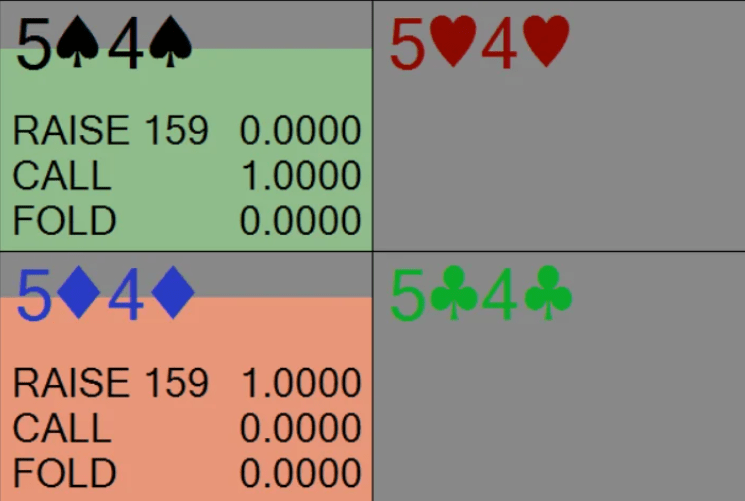
Doug should have a lot of bluffs with diamond draws. However, if you only bluff with flush draws, you won't be bluffing on flush-filling rivers. Therefore, I thought that for such cases in the range, open-ended without a flush draw would be useful. The solver does not agree with this and chooses bluffs with a matching seven, turning it into a bluff and – they block and strong straight draws. The solver also bluffs with pairs + flush draws (this will come in handy when we discuss Dwan's decision on the river).
A half-pot bet is pretty good against naked flush draws that can comfortably call and get there. Calling a straight draw without a flush draw allows you to bluff flush rivers.
In general, Doug has a wide range of bluff combinations on the turn, so raising with looks a bit dubious given that this hand plays great by calling.
As usual, when it comes to picking the perfect bluff hands, it's down to the smallest details. Therefore, I can't confidently say that raising the turn is a mistake. And yet, I really like calling with a promising draw, with which you can win a big pot in case it gets there. Instead, Doug raises the pot, being pretty far behind. No, I still agree with the solver – calls better.
When raised, Dwan must choose between slowplaying and invoking a bluff on the river, or 3-betting to stop his opponent's draws from being realized. The solver almost never 3-bets. I think this is due to the fact that Dwan has a lot of bluff catchers like , and so on, and his set calls to protect one-pair hands from river bluffs.
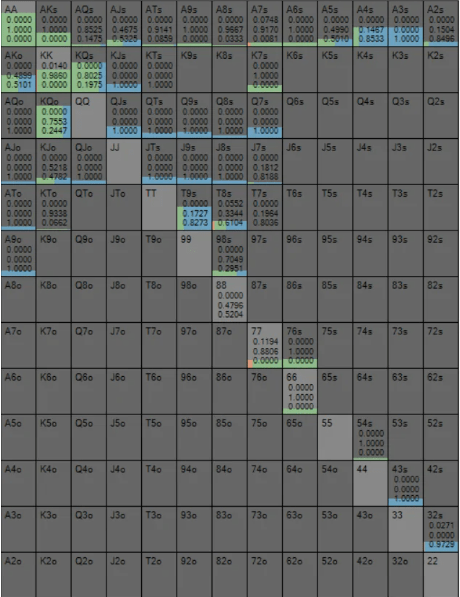
I was a bit surprised that the solver didn't want to defend against draws. It's probably because Doug's sizing is so big and Dwan has so many bluff catchers and so few sets that all sets have to be called to protect the range.
River
The most interesting street in the hand. Dwan should check with all hands. His range mainly consists of bluff catchers and trips. The six on the river is a very polarizing card for Doug's range, who is left with a bunch of missed flush draws, but he also raises on the turn. , and . It is clear that Dwan is blocking 76s and , but if we're talking about range interaction, full houses in Doug's range are 21%, while Dwan's are only 10%.
In the final simulation, the solver doesn't bluff with 54s on the turn, but in other simulations where the 54s hands raised the turn, absolutely all of these combinations bluff with large sizes. We have 5-high, the very bottom of the range, there are 65s in the range, so the bluff looks absolutely mandatory. Doug did a great job of taking this attack to the end.
Now for Dwan's long thoughts. I think the reason some viewers suspected him of nit rolling is Dwan's insecure body language. Tom managed to give the impression that he was thinking about folding, when in fact he was only choosing between calling and raising.
I watched the hand on stream, and although I understood the possible reasons for an all-in, calling seemed to me by a wide margin the most correct decision. After all, the huge turn raise and the river overbet polarized Doug's range very much, and there's no reason to shove, isolating yourself against four-of-a-kind sixes. However, in all variants of simulations, the solver bets Tom all-in every time. So Dwan thought process was legitimate.
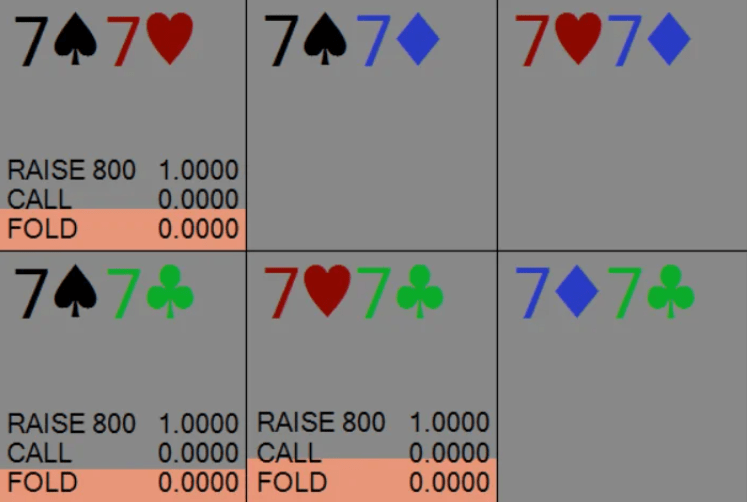
It is extremely important to note that it is very difficult for Doug to have many . I myself believe that he will always 4-bet with kings preflop. But even if he slow-plays some of these combinations, the solver does not raise with on the turn, but prefers to slowplay. Why? Because is such a strong hand, and the stacks are so deep, that a pair on the river, which completes low full houses and flushes, pays for everything. And, of course, the kings block the opponent's bluff catchers too much.
Maybe Doug would slowplay pre-flop and fast-play them on the turn. Tt's possible, but in any case, he has too few of these combinations. He also has very few four-of-a-kind, not only because it is only one combination, but because some fold on the flop and partly slowplay the turn. I think Doug could easily find a fold with a weak pair without backdoors on a flop with two overcards. The bottom line is, there is less than one combination left by the river.
Of the more obvious value hands, Doug has , possibly K6s, and a few trips that were paired on the turn with a flush draw. On the river, the trips are bound to attack Dwan's bluff catchers, and even sometimes call a shove (if all the trips are folded, Dwan's bluff all-ins will print money). But let's be realistic: Dwan is a legend, of course, but will he have the guts to check-push the river to a bluff with the correct frequency? If not, Doug can safely fold trips and even some of the smaller full houses. And if so, it makes sense to push with there isn't much else.
Complex spot, complex. Therefore, I have no doubt that Dwan was seriously thinking about him, and not slow rolling or nit-rolling. Sure, calling is safe, but if Doug is sitting with , Dwan loses half a million dollars by not going all in!
So, my verdict is that it was not a nit roll, and both players played the hand well in general, although Doug, perhaps, should have made his life easier by calmly calling the turn, and Dwan should probably have bet all-in on the river, but also scolded for calling it's not worth it.
If you liked my review, other similar texts can be found on my blog. In it, I mostly write about solvers and live poker, but next week I will go to Vegas to play in the first WSOP tournaments of my life – 6-max for $1,500, freezeout for $2,500, and then in the main event of the World Series. So stay tuned for tournament reviews!
